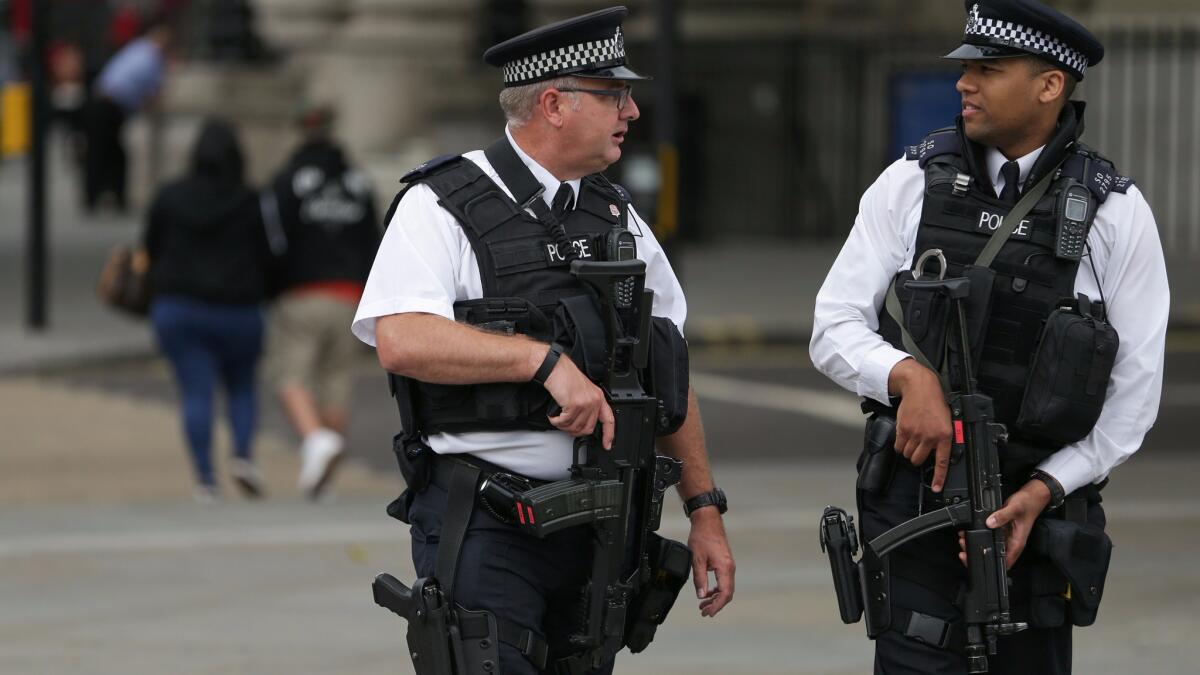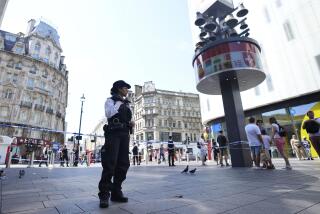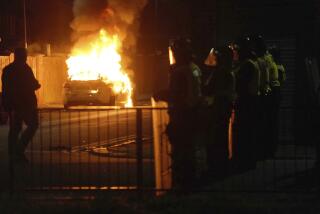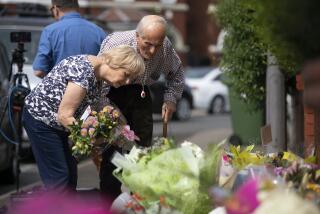American woman killed, five others injured in knife attack near London’s British Museum

- Share via
Police put more officers on London streets Thursday after a man stabbed a woman to death and injured five other people near the British Museum, just days after authorities had warned the public to be vigilant in light of attacks inspired by the Islamic State group in other parts of Europe.
The attacker was a Norwegian of Somali origin, police said, adding that they have found no signs of radicalization.
Assistant Commissioner Mark Rowley, head of counter-terrorism at the Metropolitan Police, said early indications suggested that mental health was a factor in the attack, which occurred around 10:30 p.m. Wednesday in central London’s Russell Square. Police used a stun gun to subdue the 19-year-old suspect, who was arrested on suspicion of murder and is in custody at a London police station.
Police said the victim who died was an American woman in her 60s. The five injured people are British, American, Israeli and Australian. None has life-threatening injuries. Two victims remain in the hospital; others have been discharged.
Rowley said it appeared to be a “spontaneous attack and that the victims were selected at random.”
Officers used a stun gun to subdue the 19-year-old suspect, who was arrested on suspicion of murder. Detectives from the force’s murder and terrorism squads interviewed the suspect, his family and witnesses and searched properties, and found no evidence of radicalization, Rowley said.
The National Criminal Investigation Service in Norway confirmed the suspect was a Norwegian national who had left the country in 2002.
Police said they received “numerous” calls from members of the public at around 10:30 p.m. Wednesday about a man attacking people with a knife in the streets around Russell Square, a busy central area full of students and tourists.
Student Megan Sharrock, 18, looked out her window and saw someone lying on the sidewalk under a blanket.
“There was like two rivers of blood running away from the person so we thought, yeah, someone has been killed,” she said.
Helen Edwards, 33, who lives in the area, came out for a walk and found armed police near a subway station. In a city where memories of the July 7, 2005, attacks on public transportation remain raw, she immediately suspected that an attack had occurred.
“There is always that thing in the back of your mind,” she said. “You live with that threat of terrorism or other crimes in the back of your mind. It wasn’t a huge shock, I guess.”
Ellie Cattle, 21, a student staying in a hotel near the square, said she heard police shouting: “‘Put it down, put it down!’
“Then I heard what sounded like a gunshot, but it must have been the Taser,” she said. “After that they just stopped shouting. I didn’t hear any screams from anyone.”
London Mayor Sadiq Khan called on the public to keep calm and remain vigilant, urging people to be the first line of defense against any form of attack.
“We all have a vital role to play as eyes and ears for our police and security services and in helping to ensure London is protected,” he said.
Knives are the most common murder weapon in Britain, which has strict gun-control laws. There were 186 knife killings in the year to March 2015, according to government statistics — a third of all homicides.
The incident came within hours of an announcement by London police that they were putting more armed officers on the streets. The idea was to sustain public confidence following attacks by Islamic State-inspired groups in Europe.
The move was important because police in Britain do not carry guns for the most part — a principle that remains unchanged. Even with the additional armed officers, most of London’s 31,000 police officers will not be armed.
“In some of our big iconic locations, we’ve already got armed patrols — if you look at Parliament, Downing Street — so it’s not entirely new,” Metropolitan Police Chief Bernard Hogan-Howe said Wednesday. “I think people understand that where you are going to have people as enemies who’ve got guns, we’ve got to have guns.”
The deployments underscore the challenge police face in responding to situations in which they may be outgunned — or face a pressing need to subdue a suspect. Hogan-Howe warned over the weekend that an attack in Britain was a case of “when, not if.”
ALSO
Syria’s Assad offers amnesty to rebels, who call it ‘meaningless’
The migrant crisis, as seen through the eyes of a human smuggler in Turkey
Intelligence trove provides details of Islamic State recruitment drive
UPDATES:
6:22 a.m.: Updated with additional details.
4:10 a.m.: Updated with details on the attacker.
4 a.m.: Updated with news that the victim was an American.
Aug. 4, 1:45 a.m.: Updated with details.
9:20 p.m.: Updated with quotes, details.
This article was first posted Aug. 3 at 6:15 p.m.
More to Read
Sign up for Essential California
The most important California stories and recommendations in your inbox every morning.
You may occasionally receive promotional content from the Los Angeles Times.










